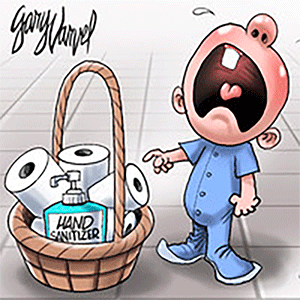In appreciation: Teri Garr was an original who fought typecasting to the end
Published in Entertainment News
She danced through so much on her way up.
Teri Garr, who died Oct. 29 at age 79 of multiple sclerosis complications, wrote in her autobiography “Speedbumps: Flooring It Through Hollywood” that as a teenager, when her fed-up mother was fighting again with Garr’s alcoholic gambler father, she’d retreat to the garage and prepare a song-and-dance show. The redirection worked. Performance, she learned, could have “a real effect on the people around me.”
By 16 she joined a “West Side Story” touring company; soon afterward she danced, sometimes uncredited, sometimes credited, in nine Elvis Presley movies and many others. If you noticed her at all in those fleeting appearances, surrounded by young women doing the same dance steps a little less interestingly, the funny in her was nearly invisible.
And then it came out, along with the astute and touching dramatic actress she rarely had the chance to access.
Tributes to Garr and her film work, including “Young Frankenstein” and her Oscar-nominated performance in “Tootsie,” flooded social media this week. “Bridesmaids” director Paul Feig put it simply, and spoke for Garr’s fans everywhere: “Truly one of my comedy heroes. I couldn’t have loved her more.”
In the little-known 1964 short film “Where’s the Bus?,” made by John Harris, there she is: dancing to Herb Alpert and the Tijuana Brass’s “Mexican Drummer Man” at the three-minute mark. Garr was 20 then, with a few Elvis movies already behind her. Shot in downtown Los Angeles, the movie’s a doodle, a suggestion at best of Garr’s potential. But in a few of her double takes, you can catch a glimmer of her future.
Ten years later, “Young Frankenstein” happened. She played Inga, the lab assistant with the vaguely Teutonic-by-way-of-backlot Transylvanian accent Garr borrowed from her pal Cher’s German wigmaker.
It’s my favorite Mel Brooks film, and looking at outtakes on YouTube scenes, it’s astonishing to realize the cosmic rightness of the casting. As written, Inga didn’t call for much more than a blond bombshell, funny-optional. Any decent burlesque comedy sketch nurse could’ve gotten by with it. Brooks went that route when he cast Lee Meredith, future burlesque comedy sketch nurse in the film version of “The Sunshine Boys,” as sex-toy secretary Ulla in “The Producers.”
Garr offered Inga a better deal. She finessed a crafty, witty take on a wearying stereotype, playing it simultaneously straight and askew. “Senk you, doctor,” she coos to Gene Wilder as she’s hoisted from ze hay Inga has been rolling in. This is after the well-known door-knocker bit; Marty Feldman, seeking entrance to the old Frankenstein castle, is on his third knock. The setup couldn’t be any cheaper or double-entendrer. Just shameless. But Wilder plays it straight (he’s truly inspired throughout) and Garr decorates her disposable three-word rejoinder with a camera-aimed toss of her tresses and a hint of smolder in her delivery.
In other words, she was funny.
Her father was a semi-successful, semi-failed vaudevillian; her mother was a one-time Rockette and a stockings model, nicknamed “Legs.” Garr, who finally got to star in a movie musical (“One From the Heart”) only to find that Francis Ford Coppola didn’t quite know how to make the musical he envisioned, had by “Young Frankenstein” nailed the art of delivering the familiar in slyly unfamiliar ways.
Brooks’ film launched Garr into stardom, albeit stardom with a bittersweet asterisk. She was typecast, early and often. Usually, she played flustered, frustrated wives of men at the center of a fantasy: as Ronnie, wondering if her husband and her marriage have gotten unworkably weird, in “Close Encounters of the Third Kind”; as Bobbie, John Denver’s incredulous wife in “Oh, God!”; and so on.
She’s terrific in “Close Encounters,” especially, though the entire apparatus of Steve Spielberg’s masterwork exists to sideline her character so that Richard Dreyfuss can scoot. In the breakdown scene at the dinner table, Garr is doing three or more things at once, almost imperceptibly. She always was. Even when perfectly still, Garr had so much going on, the zigzags in her character’s emotions and feelings doing all the dancing and keeping the scene alive and spontaneous.
With “Tootsie,” Garr excelled in her second great comic ensemble, following the murderer’s row in “Young Frankenstein.” Here too the plot sends her character, the struggling actress and sometime lover of Dustin Hoffman’s cross-dressing soap star, up the river as needed. But I love what the actor James Urbaniak posted on X Tuesday, highlighting a 26-second excerpt from “Tootsie.” Those 26 seconds, he wrote, “are a master class in comic acting, her beats are all distinct and hilarious and there’s an emotional truth under all of them. She could do it all.”
Millions got to know Garr later, mainly from her frequent appearances on “Late Show with David Letterman.” Their comic synchronicity, like that of Mariette Hartley and James Garner in all those Polaroid commercials, made many wonder: Are these two married, or something? Garr kept working, hard, but by then the MS symptoms had gotten tougher, more unpredictable, more painful. When she went public with it, she became a great and valiant spokesperson for MS awareness and research.
There was plenty of sadness peeking through Garr’s sunny public image. Long after casting directors and producers and directors started looking for “a Teri Garr type” instead of Teri Garr, she reflected: “They only write parts for women where they let everything be steamrolled over them, where they let people wipe their feet all over them. Those are the kind of parts I play, and the kind of parts that there are for me in this world. In this life.”
It’s hard to read that. It may be less true now. But not much. Garr told the Boston Globe that her big scene in “Tootsie,” confronting the Hoffman character after one too many deceptions, was largely improvised, including the part where she says, look: “I read ‘The Second Sex.’ I read ‘The Cinderella Complex.’ I’m responsible for my own orgasm!’” This “speech of exasperation,” as Garr called it, was “really about a girl being mad at the way the world is changing.”
In her time the world hadn’t changed nearly enough to afford her the breadth of roles she deserved. The ones she got, and elevated, will have to do. There really is no Teri Garr type. There was, and is, only Teri Garr.
©2024 Chicago Tribune. Visit chicagotribune.com. Distributed by Tribune Content Agency, LLC.
















Comments